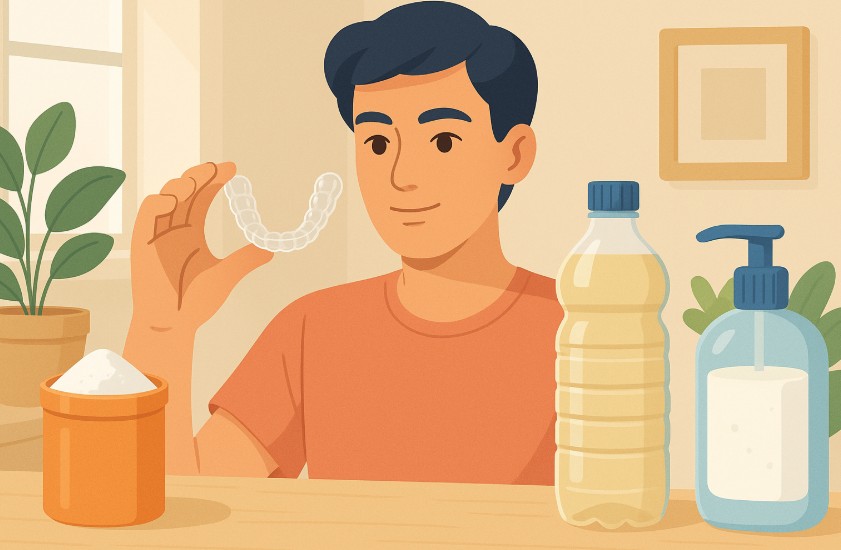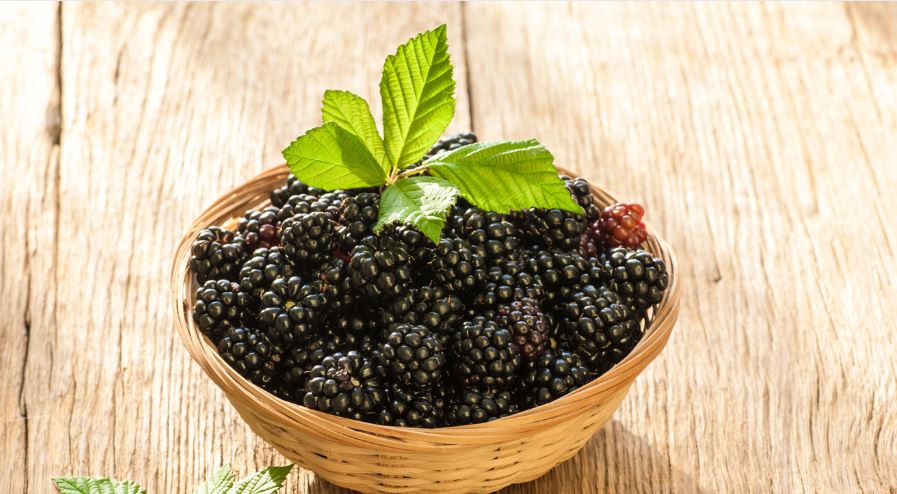Have you ever looked at your retainer and wondered if it’s really as clean as it should be? Many people wear retainers for hours daily, yet forget they need regular and proper cleaning. Just like your teeth, retainers can collect plaque, bacteria, and food particles, especially when worn overnight.
Failing to clean them not only leads to bad smells and taste, but it can also affect your oral health in the long run.
Fortunately, there are safe, effective, and natural ways to clean your retainer at home, without damaging it. Whether you have a clear plastic retainer or a traditional Hawley retainer, knowing the correct cleaning routine is essential.
In this guide, you’ll learn how to clean your retainers using household ingredients, what methods to avoid, and how to spot when it’s time for a replacement. Let’s explore how to keep your retainer fresh, bacteria-free and long-lasting from the comfort of your home.
Why Should You Clean Your Retainer Regularly?

Cleaning your retainer is just as important as brushing your teeth. You wear it inside your mouth, sometimes for 8 to 10 hours or more, meaning it can become a breeding ground for bacteria. Without proper care, this build-up can lead to serious oral hygiene issues.
Here’s why cleaning your retainer regularly should be a non-negotiable part of your daily routine:
- Bacteria and Plaque Build-up: Over time, retainers collect plaque and bacteria from your saliva, teeth, and food residue.
- Bad Breath and Taste: Unclean retainers often smell and taste unpleasant, a clear sign of bacterial activity.
- Risk of Tooth Decay and Gum Issues: Just like not brushing your teeth, wearing a dirty retainer can increase your risk of cavities and gum infections.
- Visual Changes: Milky films or white spots on the retainer indicate tartar or mineral deposits.
- Physical Damage: Bacteria can also contribute to retainer wear, leading to cracks or brittleness over time.
Ignoring these issues doesn’t just affect your retainer but also your oral health and overall hygiene. Regular cleaning ensures your appliance remains in top shape, safe to use, and effective for dental alignment. A clean retainer is more comfortable, durable, and healthy for your mouth.
Which Type of Retainer Do You Have? Does It Affect Cleaning?
Understanding the type of retainer you use is key to knowing how to clean it effectively without causing damage. Different retainers are made from different materials, and some need gentler care than others.
- Clear Plastic Retainers (Essix, Invisalign): These are the most common and are made from a thin transparent plastic. They’re prone to scratching, so they must be cleaned with a soft toothbrush and non-abrasive solutions like baking soda paste or mild soap.
- Hawley Retainers: Made of a combination of acrylic and metal wires. They’re more durable and slightly more resistant to wear. However, soaking them in harsh solutions can corrode the metal or damage the plastic.
- Permanent Retainers: These are bonded to the back of your teeth and require a different approach. You need to floss and brush thoroughly around them rather than removing and soaking them.
Each type of retainer requires a tailored cleaning approach. Using the wrong method, such as boiling water or abrasive toothpaste, could permanently damage the material.
That’s why it’s crucial to understand what kind you’re using before choosing a cleaning method. By matching the cleaning routine to the retainer type, you’ll ensure it stays clean and functions correctly.
How Often Should You Clean Your Retainer?
Your retainer should be cleaned as regularly as your teeth. Many people make the mistake of leaving it for days, allowing bacteria to multiply.
Here’s how to plan your cleaning schedule:
- Daily Cleaning: Brush your retainer gently at least once a day using a soft toothbrush. Avoid toothpaste as it’s often too abrasive. Instead, use mild dish soap or baking soda paste.
- After Each Meal (Optional): If you remove your retainer while eating, rinse it with cool water before putting it back in your mouth.
- Weekly Deep Cleaning: Once a week, give your retainer a deeper clean using a vinegar and water soak or a retainer cleaning tablet. This removes built-up plaque and eliminates odour.
- Case Cleaning: Clean your retainer case once or twice a week to prevent contamination when the retainer is not in use.
Ignoring the need for routine cleaning can lead to visible dirt, yellowing, odours, or even damage. If your retainer starts tasting odd or smells bad, it likely hasn’t been cleaned well enough. Following this simple frequency-based approach keeps both your retainer and your oral health in top shape.
Step-by-Step: 7 Safe Ways to Clean Retainers at Home
Cleaning your retainer doesn’t require expensive tools or products. Many effective cleaning methods use common household items. Below are seven proven ways to keep your retainer clean without damaging it.
1. Water for Cleaning on the Go

Water won’t deep-clean your retainer, but it is great for keeping it moist and preventing debris from hardening.
Rinse your retainer with cool water if it feels dry or dirty. If you’re away from home, keep it in a damp paper towel or soak it in a cup of distilled water until you can clean it properly.
2. Toothpaste
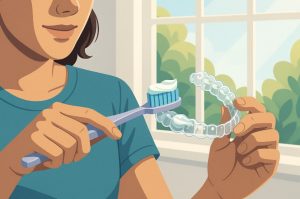
Toothpaste is commonly used, but it must be chosen carefully. Only use non-whitening, non-abrasive toothpaste.
Apply it with a soft-bristled toothbrush and scrub gently. Avoid whitening pastes as they contain gritty particles that can scratch and dull the surface of your retainer.
3. Denture Cleaner

You can occasionally use denture cleaner tablets to clean your retainer, but not daily. These products may turn retainers yellow over time. Soak your retainer for 20 minutes, then brush and rinse thoroughly to eliminate any residue or aftertaste.
4. Baking Soda
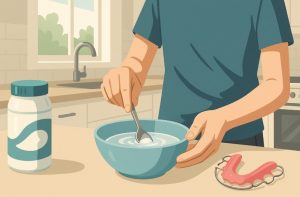
Baking soda is a natural disinfectant and deodoriser. Mix equal parts baking soda and water to form a thick paste. Use a soft toothbrush to apply it to your retainer, scrub gently, and rinse thoroughly. It helps whiten and freshen retainers without harsh chemicals.
5. Vinegar

White vinegar is an excellent natural cleaner for deep cleans. Mix equal parts vinegar and warm water. Soak your retainer for up to 30 minutes, then brush it with a soft toothbrush and rinse with cold water. This removes mineral deposits, plaque, and odours effectively.
6. Castile Soap

Castile soap is gentle and effective. Mix a small amount with warm water and soak your retainer for 2–3 minutes. Scrub with a soft toothbrush, rinse thoroughly with cool water, and it’s good to go. It’s a safer alternative to harsher dish soaps.
7. Mouthwash
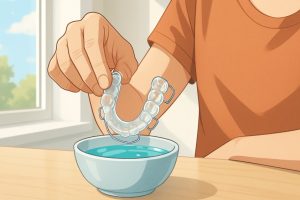
If you’re using mouthwash, make sure it’s non-alcoholic. Alcohol-based mouthwashes can dry out the retainer and cause damage. Dip the retainer briefly for 2–3 minutes and rinse it thoroughly afterward. This method is suitable when other options aren’t available.
Using these seven safe cleaning techniques can keep your retainer looking and feeling like new. Just be sure to avoid excessive use of harsh solutions, and always rinse thoroughly before wearing.
What Cleaning Mistakes Should You Avoid?
While cleaning your retainer is essential, doing it the wrong way can cause irreversible damage.
Here are some common mistakes to avoid:
- Using Hot Water: High heat can warp the plastic and make your retainer unwearable.
- Using Toothpaste with Abrasives: Some contain gritty particles that scratch the surface and encourage bacterial build-up.
- Using Alcohol-Based Mouthwashes: These can dry out the plastic and reduce the lifespan of your retainer.
- Soaking Too Long in Chemicals: Over-soaking in harsh chemicals can corrode wires and degrade plastic.
- Using Disinfectant Wipes or Bleach: These products are too harsh for items placed in the mouth.
Being aware of these mistakes helps extend the life of your retainer and keeps it hygienic and safe for daily use.
How to Store Your Retainer Safely?
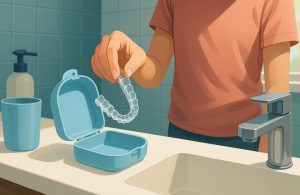
Proper storage is as important as cleaning. An unhygienic or dry environment can affect the durability and cleanliness of your retainer.
- Always Use a Clean Case: Store your retainer in a ventilated plastic case that you clean at least weekly using dish soap and warm water.
- Avoid Wrapping in Tissue or Leaving It Out: Retainers left outside can collect dust or get thrown away by accident.
- Keep It Moist: Dry retainers allow debris to harden and may crack more easily. If not in use for a while, soak it in distilled water to keep it hydrated.
- Do Not Store Near Heat: Avoid leaving your case in hot environments like a car or near a radiator.
Following these simple steps helps prevent accidental damage and ensures your retainer is always ready for safe use.
When Is It Time to Replace Your Retainer or See a Dentist?
Knowing when your retainer needs professional attention or replacement can prevent oral issues and ensure effective dental alignment.
- Unpleasant Smells or Tastes: If cleaning doesn’t help, bacteria may be embedded deep within the material.
- Cracks, Warping, or Loose Fit: Physical damage or shape loss indicates the retainer is no longer effective.
- White Spots or Films That Won’t Come Off: Mineral build-up or tartar can harden over time, requiring professional cleaning or replacement.
- Ongoing Oral Discomfort: If your retainer causes sensitivity, mouth ulcers, or discomfort, consult your dentist.
Recognising these signs early ensures your dental care remains on track and your mouth stays healthy.
Retainer Cleaning Methods Compared
With so many ways to clean retainers at home, comparing them side-by-side makes it easier to choose the right one for your needs.
| Cleaning Method | Effectiveness | Safe for Daily Use | Cautions |
|---|---|---|---|
| Water | Low | Yes | Does not clean deeply |
| Toothpaste | Medium | With non-abrasive | Avoid whitening or gritty formulas |
| Denture Cleaner | Medium | Occasionally | May stain or irritate if overused |
| Baking Soda Paste | High | Yes | Rinse thoroughly after use |
| Vinegar Soak | High | Weekly | Strong smell, avoid overuse |
| Castile Soap | High | Yes | Rinse well, choose unscented version |
| Mouthwash (non-alcoholic) | Medium | Occasionally | Alcohol versions are harmful |
| Cleaning Tablets | Very High | Weekly | Follow instructions strictly |
Choosing the right method depends on the type of retainer you have and your lifestyle. Stick to gentle, safe methods for everyday use and reserve stronger solutions for weekly deep cleaning.
Conclusion
Taking care of your retainer is a simple but vital part of your oral hygiene routine. With just a few minutes each day, you can avoid bad breath, bacterial infections, and expensive replacements.
Whether you use baking soda, vinegar, or specially designed cleaning tablets, it’s all about consistency and gentleness.
Remember to avoid harsh products, never use hot water, and always store your retainer properly in a clean, dry case. Keeping your retainer clean protects not just the appliance but your smile, too. Make it a habit, and your future dental health will thank you.
FAQs
How can I tell if my retainer needs cleaning?
If your retainer smells, tastes bad, looks cloudy, or has visible white spots, it’s time for a thorough clean.
Can I use mouthwash to clean my retainer every day?
Mouthwash can be used occasionally, but not daily, especially if it contains alcohol, which can damage the material.
What’s the safest homemade cleaner for retainers?
A paste of baking soda and water is one of the safest and most effective natural cleaners for retainers.
Why does my retainer smell even after cleaning?
It could be due to deep-seated bacteria or tartar build-up. A deeper clean or replacement might be necessary.
Is it okay to soak my retainer overnight?
Yes, but only in water or a solution recommended for overnight soaking, never in vinegar or strong chemicals.
Can cleaning a retainer too often damage it?
Not if you use the correct methods. Avoid harsh abrasives, hot water, or over-soaking in strong solutions.
How do I keep my retainer case clean?
Wash your case once or twice a week with mild soap and warm water, then let it dry completely before reuse.

